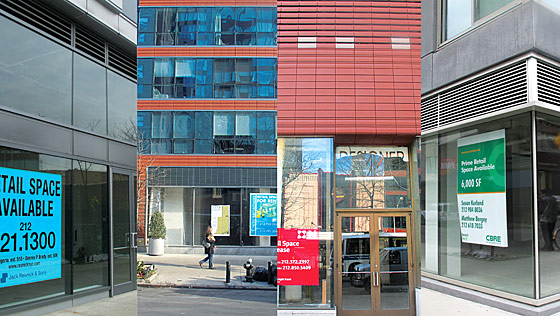
An empty storefront is a bummer, especially when it sits for months, depleting the block of its vibrancy. “It doesn’t continue to provide the kind of animated street life that most people like about cities,” says urban planner Ethel Sheffer. Vacancies in older buildings have that effect, but when they’re found in new developments, the feeling is perhaps even more pronounced. Like a pimple on a porcelain-smooth face, the juxtaposition of handsome glass-and-steel façade and papered-over storefront perturbs. “It looks incongruous,” says Sheffer; we’re left wondering where things went wrong. And there have been a lot of those incongruities of late: In Manhattan alone, at least 46 condo buildings built or converted in the past five years have 69 empty retail spaces, according to PropertyShark.com, and that’s not counting new rental towers. Brooklyn’s condo-fied neighborhoods have them, too.
The reasons for the lingering vacancies are manifold. Hobbled by the recession, the ground-floor retail market is still righting itself. The banks and Duane Reades of the world that once reliably colonized such spaces are today less acquisitive, say brokers, and discount-apparel retailers like Filene’s Basement and Daffy’s, which have stepped in to fill the vacuum, want pedestrian-heavy addresses—which wasn’t a prerequisite for the condo parts of these towers. Meanwhile, some merchants have taken the opportunity to trade up to previously unaffordable addresses, further hampering developments in less-proven locations.
Then there are the developers with suitors for their storefronts who choose to demur, lest retail tenants interfere with sales momentum. (In this market, condo buyers balk for reasons big and small.) For those going uncourted, slashing rents is a fix with risks. Condos are expensive to build, and that was especially so during the boom years, when all these buildings went up; since retail leases typically last a decade or more, it can make sense to wait for prices to turn. Some want to sell the spaces outright, but tight lending is limiting buyers. And other landlords are just skittish, wanting businesses they can be sure won’t go belly-up, says brokerage firm Newmark Knight Frank’s Ross Kaplan. “They don’t want to have to re-lease the space in a few years.”
That’s the business end; on a psychic level, these empty spaces follow a whole different math. Whereas an old boarded-up building, abandoned after its better days, speaks of a slow-motion subtraction, these luxury-wrapped shells are a reminder of an era of exponential promise suddenly cut short. The longer they sit unused the further away the fizzy times feel.
“It’s almost like a party and you’re waiting for the guest of honor to arrive,” says Sofia Song of StreetEasy.com. “The first twenty minutes you go ‘Fine.’ After an hour it’s ‘C’mon already.’ ” The gaps will be filled in, eventually; PropertyShark.com recorded a dip in this category of vacancy earlier this year, before the number climbed back up. Meanwhile we’ll have to be patient, which isn’t proving the easiest thing to learn.
Have good intel? Send tips to intel@nymag.com.